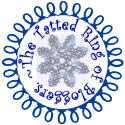Ruth Perry has had the wonderful idea to start a Facebook group called "Tatting Vintage Patterns" to study old patterns and maybe recreate them. I thought it might be just the thing to get me out of a slump. Then, when I had a lot more to say than I usually put in a FB post, I remembered my sad, neglected blog. See, better already.
The group is starting with this antique hanky, owned by the V & A Museum, image recently posted by the Lace Museum of Sunnyvale, CA. The antique hanky has a mixture of regular joins and picots tied together, so it's that transitional stage in between antique and modern methods that I really love.
I chose to work on the square motifs. This seems to have been a popular motif in the 1800's, though the stitch count varies from project to project. Here is another example from a parasol cover owned by the late Mary Konior:
Here is the version I made:
This motif has 9 little squares in the center, each made of 4 rings. I made the center section with rings: 6 - 6. The hanky has the little squares tied together at the corner picots. I started out doing it that way, but it was just too hard. (Later on, I remembered that in the old days, they would baste down all the bits and then tie the picots together.) I ended up using regular joins to connect all the outer squares to the center square, but I did not join along the outside, to preserve some of the effect of the tied picots when adding the outer round. You could join them all if you wanted to, or even use split rings to make the entire center as one piece.
The outer round has rings with bare thread in between, and the bare thread makes joins to attach to the center, and connect the center small squares. These rings are: 2 [ - 2] 9 times. (A ring of 9 picots with 2 ds in between and on each side.) At the corners, I made a lock join immediately before and after the rings to try to center them over the corners. When there are 2 rings adjacent without a join to the center, I made a lock join into the last p of the first ring so there wasn't a really long bit of bare thread. When joining to the center, I made the lock join through both picots of the center squares together.
A bit of blocking would have made this look neater, but I think it's a good try to recreate the original. This has been fun.









.jpg)


































